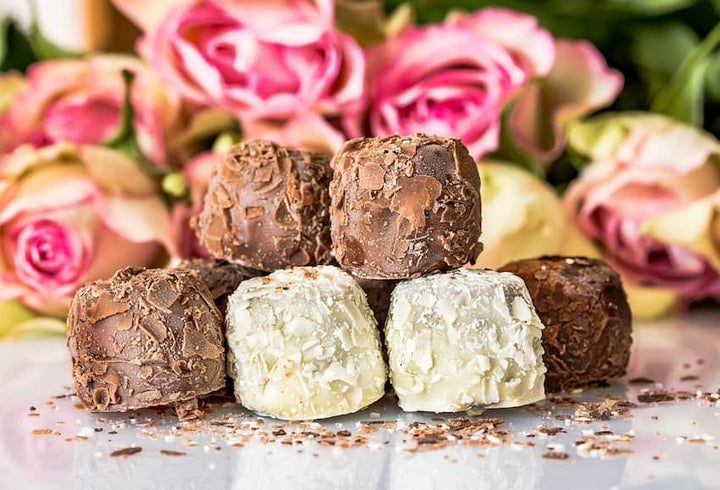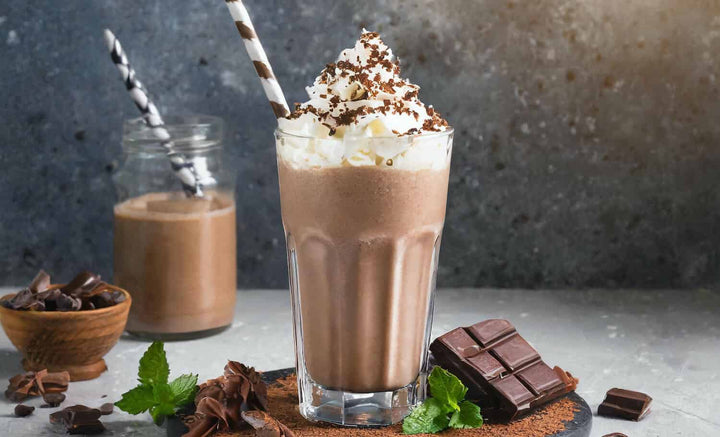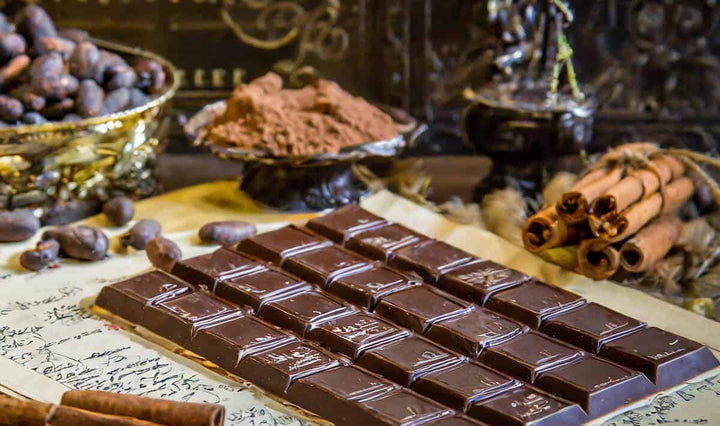Praline chocolate has long been a staple in the repertoire of confectioners and chocolatiers, captivating the palates of those who relish the symphony of textures and flavours within.
Originating from the culinary traditions of France and Belgium, praline chocolate combines the crunch of nuts and the decadence of sugar, harmoniously enrobed in velvety chocolate.
This post will look into the sweet world of praline chocolate, exploring its origins, versatile manifestations, and craftsmanship in creating this cherished confection.
What is Praline Chocolate?
Praline chocolate is a confection characterised by its distinctive blend of textures and flavours, marrying the creaminess of chocolate with the crunchy richness of nuts and the sweetness of sugar.
The term "praline" traditionally refers to a confection made from nuts—often almonds or hazelnuts—that are caramelised in sugar.
When enveloped in chocolate, this confection transforms into praline chocolate.
Origin:
Praline chocolate has its roots in the culinary traditions of France and Belgium, each bringing its unique touch to this versatile confection.
The French version of praline typically involves almonds and caramelised sugar, while the Belgian variant is renowned for filling ground nuts and sugar, encased in a shell of smooth chocolate.
Composition:
At its core, praline chocolate typically consists of a mixture of finely ground nuts—usually hazelnuts or almonds—and sugar.
This nutty, sweet mixture, known as praliné, is often combined with chocolate to create various forms of praline chocolates.
Some pralines are filled with a creamy praliné paste, while others may feature whole or chopped nuts enveloped in chocolate, providing a delightful contrast of textures.
Variations:
Praline chocolate comes in myriad variations and formulations, ranging from truffles and bonbons to chocolate bars.
The choice of chocolate—be it dark, milk, or white—adds another layer of complexity to the flavour profile of praline chocolates, allowing chocolatiers to craft a diverse array of tantalising creations.
Enjoyment:
Praline chocolate is celebrated for its harmonious interplay of flavours and textures, offering a satisfying crunch and a melt-in-the-mouth experience.
It's a versatile treat, enjoyed on its own or as a complement to various desserts and pastries, enhancing the gastronomic experience with its sweet, nutty richness.
Praline chocolate is a symphonic confection, a dance of sweetness, nuttiness, and chocolatey richness, revered by connoisseurs and casual enthusiasts alike for its delectable charm and multifaceted palate.
What Are the Ingredients in Praline Chocolate?
Creating praline chocolate involves a harmonious amalgamation of carefully selected ingredients, each contributing its unique essence to the final confection.
Below is a simple chart delineating the primary components found in praline chocolate:
| Ingredient | Purpose |
|---|---|
| Nuts (usually hazelnuts or almonds) | Provide texture and a rich, nutty flavour |
| Sugar | Adds sweetness and contributes to texture |
| Chocolate | Envelops the praline, adding depth and richness |
| Cream (optional) | Used in some variations to create a creamy texture |
Expanding on the Ingredients:
-
Nuts (usually hazelnuts or almonds): Nuts are the soul of praline chocolate, imparting the signature crunch and flavour. Hazelnuts and almonds are commonly used, either whole, chopped, or ground, creating a spectrum of textures within the chocolate. These nuts are often caramelised or roasted to accentuate their inherent richness and depth.
-
Sugar: Sugar is indispensable in creating praline chocolate, bringing sweetness and contributing to the confection's overall texture. When caramelised with nuts, it encases them in a sweet, crispy layer, enhancing the praline’s flavour profile.
-
Chocolate: Chocolate acts as the velvety cloak that envelops the praline. Each variant can be dark, milk, or white, bestowing its unique cocoa notes and sweetness levels, creating a harmonious balance with the nutty centre. The quality of the chocolate is crucial in determining the overall taste and quality of praline chocolate.
-
Cream (optional): In some praline variations, the cream is incorporated to achieve a luxuriously smooth and creamy texture, especially when creating praliné paste. It adds a lusciousness to the chocolate, complementing the crunchy texture of the nuts.
Crafting praline chocolate is a meticulous art, blending these ingredients with precision and care to forge a confection that is a feast for the senses, a delightful interplay of contrasting textures and harmonising flavours.
The combination of crisp, nutty, praline and smooth, rich chocolate makes this treat a timeless favourite among chocolate aficionados.
What Are the Nutrients in Praline Chocolate?
Praline chocolate is not only a delicious indulgence, but it also packs a variety of nutrients owing to its diverse ingredients.
Here’s a simple chart delineating the nutritional components typically found in praline chocolate:
| Nutrient | Benefit |
|---|---|
| Dietary Fibre | Aids digestion and promotes gut health |
| Healthy Fats | Supports cell structure and energy supply |
| Proteins | Essential for tissue repair and growth |
| Antioxidants | Helps in combating oxidative stress |
| Vitamins (e.g. Vitamin E) | Contributes to skin and eye health |
| Minerals (e.g. Magnesium, Calcium) | Supports bone health and muscle function |
Expanding on the Nutrients:
-
Dietary Fibre: Present in nuts and cocoa, dietary fibre is essential for maintaining healthy digestion and regulating blood sugar levels. It also contributes to overall gut health, preventing constipation and promoting a feeling of fullness.
-
Healthy Fats: The nuts in praline chocolate are rich in healthy fats, which are crucial for cellular structure and provide a sustained source of energy. These predominantly unsaturated fats are beneficial for heart health and can help reduce inflammation.
-
Proteins: Proteins are fundamental building blocks for tissues, muscles, and enzymes. Including nuts in praline chocolates provides a good source of plant-based proteins, aiding in tissue repair and growth.
-
Antioxidants: Antioxidants are abundant in both chocolate and nuts. They play a vital role in neutralising free radicals in the body, thus helping combat oxidative stress and reducing the risk of chronic diseases.
-
Vitamins (e.g. Vitamin E): Vitamin E, found in nuts like almonds and hazelnuts, is a powerful antioxidant that is essential for maintaining healthy skin and eyes and supports the immune system.
-
Minerals (e.g. Magnesium, Calcium): Praline chocolate is a source of essential minerals like magnesium and calcium, which are crucial for bone health, nerve function, and muscle contraction.
While praline chocolate is undeniably nutritious, it’s also rich in sugars and calories and thus should be enjoyed in moderation as part of a balanced diet.
When consumed mindfully, praline chocolate can be a delightful way to incorporate a variety of essential nutrients into your diet, all while indulging in a symphony of flavours and textures.
What’s the Difference Between Chocolate Truffles and Praline?
Chocolate truffles and pralines are both exquisite confections, highly valued in the world of chocolates, yet they exhibit distinctive characteristics in terms of composition, texture, and flavour profiles.
Composition and Texture:
Chocolate truffles generally comprise a ganache centre— a creamy mixture of chocolate and cream, occasionally infused with various flavours like liqueurs, fruits, or spices.
This centre is typically enrobed in chocolate and may be rolled in cocoa powder, nuts, or other coatings.
The result is a rich, velvety confection, marked by its creamy texture and indulgent flavours.
Pralines, on the other hand, are centred around a core of caramelised nuts.
This crunchy, nutty centre can either be whole, chopped, or ground, and it's usually enveloped in chocolate.
The combination of the crispy, nutty praline and smooth chocolate yields a contrasting and harmonious texture and flavour.
Flavour Profile:
The flavour of chocolate truffles tends to be more robust and rich, thanks to the ganache centre, which can be crafted to hold an array of intricate flavours, ranging from the sweetness of fruits to the boldness of spirits.
Pralines offer a different yet equally enchanting experience, bringing forth the sweet and nutty notes of the caramelised nuts, harmoniously balanced by the depth and richness of the chocolate.
The choice of nuts and chocolate variety can significantly influence the overall flavour profile of the praline, allowing for a broad spectrum of taste experiences.
Summary:
In essence, while both chocolate truffles and pralines are luxurious treats, the primary difference lies in their core components and the sensory experiences they provide.
Truffles are celebrated for their creamy, rich ganache centres and versatile flavour infusions, offering a melt-in-the-mouth experience.
In contrast, pralines are revered for their crunchy, sweet, and nutty centres, enveloped in luscious chocolate, providing a delightful interplay of textures and flavours.
Each confection holds its unique charm, catering to different preferences and occasions, yet both remain timeless embodiments of the chocolate-making artistry, bringing joy and indulgence to those who savour them.
How is Praline Chocolate Manufactured?
Creating praline chocolate is a meticulous process involving several steps, each crucial in forging the confection's distinctive texture and flavour profile.
Below is an outlined journey of praline chocolate from raw ingredients to the delectable finished product:
1. Selection of Ingredients:
Quality ingredients are the foundation of exquisite praline chocolate. P
Premium nuts—typically almonds or hazelnuts—are chosen along with high-quality chocolate and sugar.
2. Roasting and Caramelising:
The nuts are often roasted to intensify their flavour and aroma. Subsequently, they are caramelised with sugar, creating the crunchy, sweet core characteristic of praline.
3. Grinding:
Depending on the desired texture of the praline, the caramelised nuts may be ground to varying degrees of fineness.
Some pralines feature finely ground praliné paste, while others may contain chunks or whole pieces of caramelised nuts.
4. Mixing with Chocolate:
The praliné, whether coarse or fine, is then mixed with tempered chocolate to form the desired shape and size of the praline chocolate.
This stage can involve crafting a shell of chocolate to encase the praliné or combining the praliné with chocolate to form bars or other shapes.
5. Setting and Cooling:
Once shaped, the praline chocolates are left to set and cool, allowing the chocolate to crystallise and harden, encapsulating the nutty core in a smooth, velvety layer.
6. Packaging:
After the praline chocolates have been set, they are carefully packaged to preserve their freshness and quality, ready to be enjoyed by discerning palates.
7. Quality Assurance:
Throughout the manufacturing process, stringent quality checks are in place to ensure that each piece of praline chocolate meets the high standards set by the chocolatier, ensuring consistency in flavour, texture, and overall quality.
This intricate process, marked by passion and precision, underscores the artistry of creating praline chocolate.
Each step is a dance between tradition and innovation, culminating in a confection that is a harmonious symphony of textures and flavours, a true celebration of the craft of chocolate-making.
How To Make Praline Chocolate - A Recipe
Creating praline chocolate at home can be a delightful and rewarding experience.
Here’s a simple yet delectable recipe to make your own praline chocolate.
Ingredients:
- 200g Hazelnuts or Almonds
- 200g Granulated Sugar
- 200g Dark or Milk Chocolate
- A pinch of Sea Salt (optional)
Instructions:
Step 1: Preparing the Nuts
- Preheat your oven to 180°C.
- Spread the nuts evenly on a baking tray and roast them for about 10-12 minutes or until they are golden and fragrant.
- Once roasted, let them cool slightly and rub them in a clean kitchen towel to remove the skins.
Step 2: Caramelising the Nuts
- In a heavy-bottomed pan, melt the sugar over medium heat. Refrain from stirring; instead, gently swirl the pan to prevent burning.
- Once the sugar has completely melted and turned a golden-brown caramel colour, add the roasted nuts to the pan and stir to coat them evenly with the caramel.
- Pour the caramel-coated nuts onto a parchment-lined tray, spreading them out as much as possible. Sprinkle with sea salt if desired, and allow them to cool completely.
Step 3: Grinding the Nuts
- Once the caramelised nuts have cooled and hardened, break them into smaller pieces.
- Transfer the pieces to a food processor and pulse until you achieve your desired praline texture – either finely ground or a little chunky, according to your preference.
Step 4: Preparing the Chocolate
- Temper the chocolate by melting 2/3 of it over a double boiler or in a heatproof bowl in the microwave, in 20-second intervals.
- Once melted, remove from heat and add the remaining 1/3 of the chocolate, stirring continuously until it’s fully melted and the mixture is smooth.
Step 5: Mixing and Setting
- Mix the ground praline into the melted, tempered chocolate until well combined.
- Pour the mixture into moulds or spread it onto a parchment-lined tray, smoothing the top with a spatula.
- Allow the praline chocolate to set completely at room temperature or in the refrigerator.
Step 6: Demoulding and Enjoying
- Once the praline chocolate is set, de-mould or break it into pieces.
- Savour your homemade praline chocolate, or share it with friends and family as a delightful homemade gift.
Remember, praline chocolate's magic lies in its harmonious blend of ingredients.
Enjoy the process, and don’t hesitate to experiment with different nuts or chocolate varieties to find your perfect praline.
Some Notes From an Expert Chocolatier
Creating chocolates at home is a truly delightful venture, allowing enthusiasts to immerse themselves in the meticulous and rewarding process of chocolate-making.
Here at Whitakers, we hold a profound appreciation for the artistry and precision that goes into crafting every piece of chocolate, and we genuinely commend those who embark on this journey at home.
When you create your chocolates, you gain the invaluable advantage of knowing every ingredient that goes into each piece, allowing for complete control over quality, flavour, and nutritional content.
It offers a clear path to avoid additives and preservatives, ensuring a clean, wholesome indulgence.
However, achieving a premium taste is highly contingent on using natural, top-quality ingredients.
Sourcing the finest cocoa, choosing premium nuts, and selecting the best sweeteners are crucial steps to attaining that exquisite, professional taste that is characteristic of high-quality chocolates.
By using superior ingredients, you can ensure that each bite is a harmonious blend of flavours and textures, elevating your homemade creations to the level of gourmet delicacies.
Final Notes On Praline Chocolate
Praline chocolate is a decadent symbol of culinary artistry, encapsulating a harmonious symphony of textures and flavours.
It combines caramelised nuts' crunchy, sweet nuances with chocolate's rich, velvety luxury, providing a multi-sensorial experience that dances on the palate.
For those exploring the world of homemade praline chocolate, the journey is as rewarding as the destination, offering insights into the meticulous craftsmanship and precision inherent to the chocolate-making process.
Using natural, high-quality ingredients is paramount, and this commitment to excellence transforms an ordinary confection into a gourmet delight.
It allows chocolate enthusiasts to traverse beyond the superficial taste experience, delving into a profound appreciation for the harmonious interplay of ingredients, textures, and flavours.











